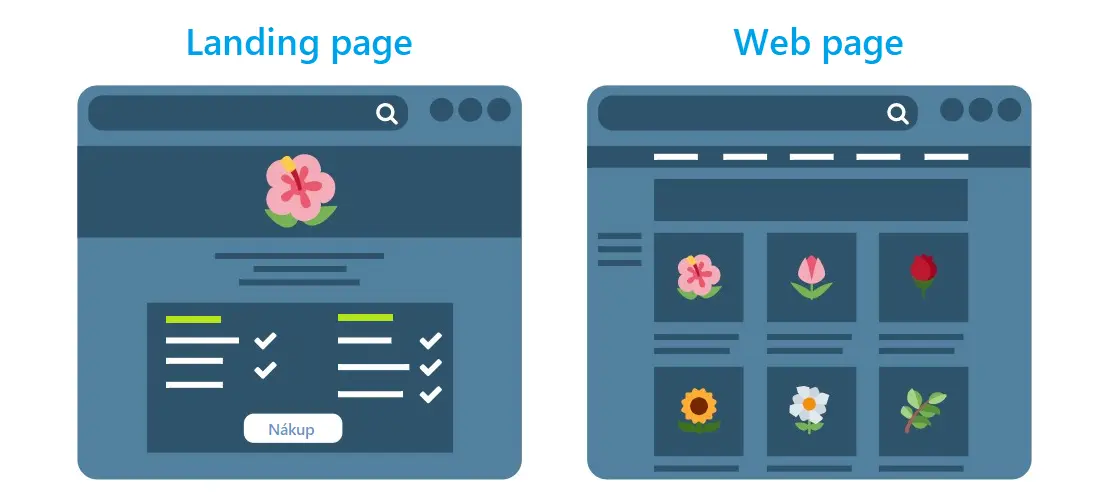Table of Contents:
- What is the difference between a website and a landing page?
- Website
- Landing Page
- What is the difference between a website and a landing page?
- Conclusion:
Last updated December 6th, 2023 00:26
When creating a website, whether on WordPress or using other systems, you can choose several strategies to target your customers or users. One of the strategies is how the page will look and what purpose it will primarily serve. Essentially, the page can be divided into the aforementioned landing page or a classic website. In this article, we will discuss, what is the difference between a website and a landing page, specifically in terms of their basic distinguishing features.
What is the difference between a website and a landing page?
Website
A website is designed with the assumption that the reader will collect information gradually. This is done through clicks on sub-pages with narrower focus. Typically, the main page structure includes links to other topics. A website usually has a menu containing links like “contact,” “pricing,” or “about us.”
As the reader navigates the website, they obtain information about the owner or company, products, philosophy, or pricing. A website does not aim at the call to action (CTA). This is the main difference between a website and a landing page.
CTA (Call To Action) is precisely the primary purpose of a landing page. The primary goal of websites is to provide basic information to help users understand who you are, what you do, and how they can contact you.
Call to action
Call to action (CTA) is a key element of online marketing that motivates website visitors to take a specific action. This can include downloading an e-book, signing up for a newsletter, making a purchase, or filling out a contact form.CTA is typically located at the end of a webpage, on a button or link that urges visitors to take the desired action. Phrases like "Buy Now," "Subscribe," or "Download Your Free E-book" are commonly used.
It's important for the CTA button or link to be easily visible and understandable. When creating a CTA strategy, it's also important to make sure it catches visitors' attention and persuades them to take action, for example, by offering useful content or an attractive deal.
Landing Page
As mentioned earlier, a landing page is designed with a strong focus on conversion rates and CTA. It is built in such a way as to encourage users to take a specific action, such as placing an order, signing up for a newsletter, or taking other actions.
Conversion rate
The conversion rate is the ratio between the number of people who visit your website and the number of those who complete the desired action, such as a purchase or registration. You can calculate the conversion rate as the percentage of successful conversions compared to the total number of visitors.A high conversion rate means that your website is effective and convincing visitors to complete the desired action. If you have a low conversion rate, it may mean that your website is not convincing enough or not targeting the right audience.
Measuring the conversion rate will help you compare the success of different advertising campaigns and optimize your website and ads to improve the conversion rate. If you want to increase the conversion rate, you can try different strategies, such as changing the target audience or improving the design of your ads and pages.
Compared to a regular website, a landing page is usually focused directly on a specific product, describing it and targeting the customer or user to make a purchase or order.
A landing page is also heavily focused on the conversion rate. It measures, for example, how many users came to the page from social media. And, also, how many of them completed an order, registered, or purchased the product. The landing page is thus more marketing-oriented.
In advertising campaigns, a regular website and a landing page can complement each other perfectly. On one hand, you have a classic website with information about your company, its products, and contact details for you or your customer support. On the other hand, for promoting a specific product on social media, a landing page is more suitable. When users see a paid advertisement on social media and click on it, they will be taken to the landing page for that particular product. Here, it will be important to convince them that your product is the key for them.

What is the difference between a website and a landing page?
Conclusion:
In summary, this is the difference between a traditional website and a landing page. If you want to use landing pages on your website, it is recommended to also focus on tracking conversion rates. This means measuring how effective such a page is in relation to the number of users who land on it. This can be done through tools such as Google Analytics and others. But more on that another time.
Byl pro Vás tento článek užitečný?
Klikni na počet hvězd pro hlasování.
Průměrné hodnocení. 0 / 5. Počet hlasování: 0
Zatím nehodnoceno! Buďte první
Je mi líto, že pro Vás nebyl článek užitečný.
Jak mohu vylepšit článek?
Řekněte mi, jak jej mohu zlepšit.

Subscribe to the Newsletter
Stay informed! Join our newsletter subscription and be the first to receive the latest information directly to your email inbox. Follow updates, exclusive events, and inspiring content, all delivered straight to your email.
Are you interested in the WordPress content management system? Then you’ll definitely be interested in its security as well. Below, you’ll find a complete WordPress security guide available for free.

